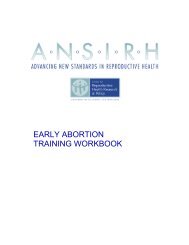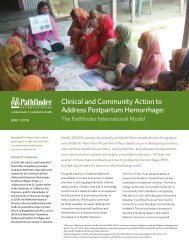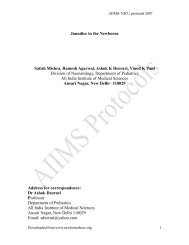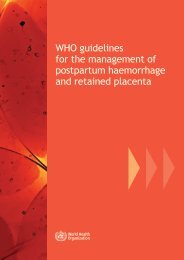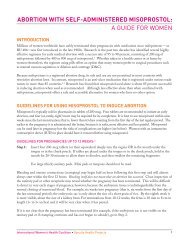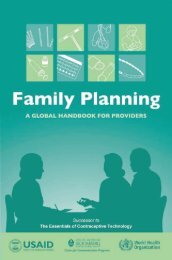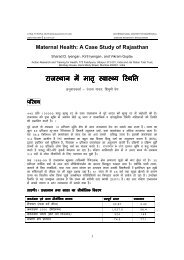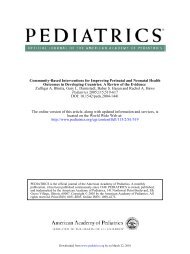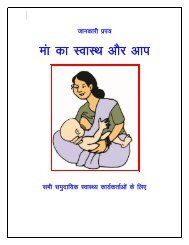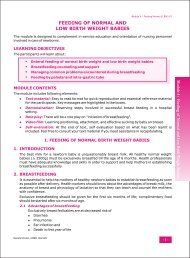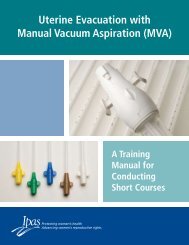Gender Gaps in Research on Abortion in India - CommonHealth
Gender Gaps in Research on Abortion in India - CommonHealth
Gender Gaps in Research on Abortion in India - CommonHealth
Create successful ePaper yourself
Turn your PDF publications into a flip-book with our unique Google optimized e-Paper software.
I. CONTEXT<br />
In a global c<strong>on</strong>text where <str<strong>on</strong>g>in</str<strong>on</strong>g>duced aborti<strong>on</strong> is restricted by law and even crim<str<strong>on</strong>g>in</str<strong>on</strong>g>alised <str<strong>on</strong>g>in</str<strong>on</strong>g> several<br />
countries, <strong>India</strong> enjoys the dubious dist<str<strong>on</strong>g>in</str<strong>on</strong>g>cti<strong>on</strong> of be<str<strong>on</strong>g>in</str<strong>on</strong>g>g a country where aborti<strong>on</strong> is legal but largely<br />
unsafe and unavailable. In 1972, with the implementati<strong>on</strong> of the Medical Term<str<strong>on</strong>g>in</str<strong>on</strong>g>ati<strong>on</strong> of Pregnancy<br />
(MTP) Act of 1971, <strong>India</strong> jo<str<strong>on</strong>g>in</str<strong>on</strong>g>ed 25 other countries, which had enacted a legislati<strong>on</strong> decrim<str<strong>on</strong>g>in</str<strong>on</strong>g>alis<str<strong>on</strong>g>in</str<strong>on</strong>g>g<br />
aborti<strong>on</strong> and mak<str<strong>on</strong>g>in</str<strong>on</strong>g>g it legally available.<br />
The MTP Act of 1971 permitted aborti<strong>on</strong>s to be performed not <strong>on</strong>ly <strong>on</strong> therapeutic and eugenic grounds,<br />
but also for humanitarian reas<strong>on</strong>s such as pregnancy result<str<strong>on</strong>g>in</str<strong>on</strong>g>g from rape, for pregnancy result<str<strong>on</strong>g>in</str<strong>on</strong>g>g from<br />
c<strong>on</strong>traceptive failure, and for 'social' reas<strong>on</strong>s: 'where actual or reas<strong>on</strong>ably foreseeable envir<strong>on</strong>ment<br />
(social/ec<strong>on</strong>omic) would lead to risk of <str<strong>on</strong>g>in</str<strong>on</strong>g>jury to the health of the mother.<br />
Assessments of <strong>India</strong>'s aborti<strong>on</strong> scenario <str<strong>on</strong>g>in</str<strong>on</strong>g> the 1990s raised an alarm bell. The legalisati<strong>on</strong> of aborti<strong>on</strong><br />
had not solved the problem of morbidity and mortality related to septic aborti<strong>on</strong>. A larger number of<br />
women were found to be seek<str<strong>on</strong>g>in</str<strong>on</strong>g>g aborti<strong>on</strong> services outside the approved facilities <str<strong>on</strong>g>in</str<strong>on</strong>g> the 1990s than was<br />
the case <str<strong>on</strong>g>in</str<strong>on</strong>g> the 1960s when c<strong>on</strong>cern <strong>on</strong> this score brought about the MTP legislati<strong>on</strong> (3). Mortality from<br />
septic aborti<strong>on</strong>s was estimated to range from 11% to 20% of all maternal deaths <str<strong>on</strong>g>in</str<strong>on</strong>g> the late 1990s (53).<br />
<strong>India</strong>'s MTP Act was champi<strong>on</strong>ed by medical practiti<strong>on</strong>ers who were c<strong>on</strong>cerned with the high toll that<br />
septic aborti<strong>on</strong>s took <strong>on</strong> women's lives, as well as those who saw <str<strong>on</strong>g>in</str<strong>on</strong>g>duced aborti<strong>on</strong>s as a resp<strong>on</strong>se to<br />
<strong>India</strong>'s grow<str<strong>on</strong>g>in</str<strong>on</strong>g>g populati<strong>on</strong>.<br />
A 1965 article suggests that legalis<str<strong>on</strong>g>in</str<strong>on</strong>g>g <str<strong>on</strong>g>in</str<strong>on</strong>g>duced aborti<strong>on</strong>s would 'rapidly br<str<strong>on</strong>g>in</str<strong>on</strong>g>g down the rate of populati<strong>on</strong><br />
growth <str<strong>on</strong>g>in</str<strong>on</strong>g> <strong>India</strong>', and could be used 'till the populati<strong>on</strong> is educated <str<strong>on</strong>g>in</str<strong>on</strong>g> modern c<strong>on</strong>traceptive methods'. 1<br />
Articles published after the enactment of the MTP law also saw the move 'as <strong>on</strong>e of the most recent<br />
steps taken by the government towards check<str<strong>on</strong>g>in</str<strong>on</strong>g>g populati<strong>on</strong> growth.' 2, 3<br />
However, there were others who c<strong>on</strong>ceived of the MTP Act as a health measure. An editorial appear<str<strong>on</strong>g>in</str<strong>on</strong>g>g<br />
<str<strong>on</strong>g>in</str<strong>on</strong>g> the <strong>India</strong>n Journal of Public Health <str<strong>on</strong>g>in</str<strong>on</strong>g> 1972 emphatically states that '<strong>on</strong>e important po<str<strong>on</strong>g>in</str<strong>on</strong>g>t to note is that<br />
this measure (the Act) is not a birth c<strong>on</strong>trol measure but a measure for prevent<str<strong>on</strong>g>in</str<strong>on</strong>g>g mortality and<br />
morbidity am<strong>on</strong>gst the mothers.' 4<br />
Unlike <str<strong>on</strong>g>in</str<strong>on</strong>g> many countries of the world where liberalisati<strong>on</strong> of aborti<strong>on</strong> was and is a central demand of<br />
the women's movement, <str<strong>on</strong>g>in</str<strong>on</strong>g> <strong>India</strong> aborti<strong>on</strong> was never framed as a women's reproductive rights issue,<br />
affect<str<strong>on</strong>g>in</str<strong>on</strong>g>g women's ability to c<strong>on</strong>trol their sexuality and fertility. Writ<str<strong>on</strong>g>in</str<strong>on</strong>g>gs by medical practiti<strong>on</strong>ers <str<strong>on</strong>g>in</str<strong>on</strong>g> the<br />
years follow<str<strong>on</strong>g>in</str<strong>on</strong>g>g the legalisati<strong>on</strong> of aborti<strong>on</strong> make this amply clear. Many medical practiti<strong>on</strong>ers saw<br />
aborti<strong>on</strong> as a necessary evil subject to misuse by irresp<strong>on</strong>sible 'lay people', and the role of the physician<br />
was to ensure that it was not misused. 5 It was feared that women's 'aborti<strong>on</strong>-pr<strong>on</strong>eness' had <str<strong>on</strong>g>in</str<strong>on</strong>g>creased<br />
because of the publicity follow<str<strong>on</strong>g>in</str<strong>on</strong>g>g the legalisati<strong>on</strong>. 6 A study <strong>on</strong> the 'problem of unmarried mothers'<br />
c<strong>on</strong>demns the legislati<strong>on</strong> for c<strong>on</strong>tribut<str<strong>on</strong>g>in</str<strong>on</strong>g>g to an <str<strong>on</strong>g>in</str<strong>on</strong>g>crease <str<strong>on</strong>g>in</str<strong>on</strong>g> 'pre-marital sexual excursi<strong>on</strong>s, as this (the<br />
MTP Act) has removed from the m<str<strong>on</strong>g>in</str<strong>on</strong>g>ds of unmarried girls the fear of social ostracism by removal of the<br />
unwanted foetus'. The study holds the 'unmarried mothers' resp<strong>on</strong>sible for 'enter<str<strong>on</strong>g>in</str<strong>on</strong>g>g <str<strong>on</strong>g>in</str<strong>on</strong>g>to <str<strong>on</strong>g>in</str<strong>on</strong>g>cestuous<br />
relati<strong>on</strong>ships' motivated by 'sexual urge' and try<str<strong>on</strong>g>in</str<strong>on</strong>g>g to cover up this naked truth with 'many excuses'. 7<br />
1. Sengupta B. Liberalisati<strong>on</strong> of aborti<strong>on</strong> as a populati<strong>on</strong> c<strong>on</strong>trol measure. <strong>India</strong>n Journal of Public Health Vol ix no.2,<br />
April 1965, pp 69-73<br />
2. Goraya R, Mohan D, Agarwal N, Takkar D, H<str<strong>on</strong>g>in</str<strong>on</strong>g>gorani V. A pilot study of demographic and psychosocial factors <str<strong>on</strong>g>in</str<strong>on</strong>g> Medical<br />
Term<str<strong>on</strong>g>in</str<strong>on</strong>g>ati<strong>on</strong> of Pregnancy. Journal of <strong>India</strong>n Medical Associati<strong>on</strong> Vol 61 No.11, 1975. pp 309-315<br />
3. Roy M, Ghosh BN, Lahiri BC. <strong>India</strong>n Journal of Public Health Vol. XXI no.2, 1977, pp.83-88<br />
4. Editorial, <strong>India</strong>n Journal of Public Health, Vol. XVI no.2, 1972, pp37-38.<br />
5. Ghosh N. Misuse of Medical Term<str<strong>on</strong>g>in</str<strong>on</strong>g>ati<strong>on</strong> of Pregnancy. Editorial, Journal of the <strong>India</strong>n Medical Associati<strong>on</strong>, Vol 80 No.1,<br />
1983, pp 32-33.<br />
6. Lahiri D, K<strong>on</strong>ar M. Aborti<strong>on</strong> hazards. Journal of the <strong>India</strong>n Medical Associati<strong>on</strong>, Vol 66 no.11, 1976, pp.288-94<br />
7. Mandal KT. Problem of unmarried mothers. Journal of the <strong>India</strong>n Medical Associati<strong>on</strong> Vol.79 No. 5&6, 1982.<br />
1



